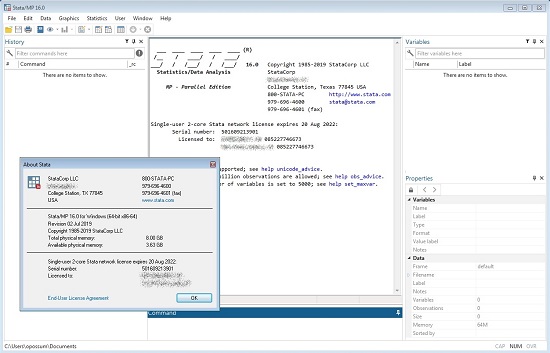StataCorp Stata 16.0
File Size: 414 MiB
StataCorp announces the 16th major release of its data science software-Stata. Stata has been a mainstay of health, economic, social science, and business researchers for 34 years. This latest release will not only delight Stata's core users but also entice other data scientists to take a fresh look at Stata.
StataCorp Stata 16 release notes - Date: July 09, 2019
Stata 16 adds lasso models as Stata introduces its first official suite of commands for machine learning. True to Stata's roots in statistical methods, its lasso tools provide not just model selection and prediction but inferential lasso models that allow researchers to estimate the effects that answer real scientific questions.
This release also expands Stata's tools for reproducible reporting. Release 16 includes more automation of Word documents that include both statistical and graphical results. Its dynamic features allow reports to update automatically as data update. And Stata's integrated versioning ensures users can reproduce any results, any time.
Stata's core user camps will be pleased that release 16 incorporates a complete suite of meta-analysis features. The new suite-with additions such as forest plots and meta-regression-allows users to combine results from multiple studies in a principled way.
The new integration with Python will appeal to more technical data scientists. Stata now has seamless two-way communication with Python, including instructions, data, and metadata. The integration provides access to the full range of Python packages-machine learning, 3-D graphics, data scraping, and more. Alan Riley, Vice President of Software Development, said, "Stata and Python are perfect complements. I keep finding reasons to use them together, and I can't wait to see what our users create."
Stata already possessed the most approachable set of Bayesian analysis features available-opening Bayesian statistics to those otherwise put off by the specialized requirements of other software. Release 16 adds support for multiple chains, Bayesian predictions, the Gelman-Rubin convergence diagnostic, and posterior predictive p-values.
Release 16 further extends Stata's unique extended regression models. These models address common problems that arise in data-endogenous covariates (unobserved confounding), sample selection, and nonrandom treatment assignment. What is unique is that all problems can be handled simultaneously. As Vince Wiggins, Vice President of Scientific Development, stated, "The statistics aren't new, just the way we stitched them together." Stata 16 adds panel data (multilevel data) to the allowed problems list.
As usual, StataCorp packs lots of new features into each new release. Features not mentioned above include multiple datasets in memory, importing from SAS and SPSS, nonparametric series regression, sample-size analysis for confidence intervals, panel-data mixed logit, nonlinear DSGE models, multiple-group IRT, panel-data Heckman-selection models, time extensions for nonlinear mixed-effects models for pharmacokinetic models and growth models, numerical integration, linear programming, and Do-file Editor autocompletion.
StataCorp Stata/MP lets you analyze data in one-half to two-thirds the time compared with Stata/SE on inexpensive dual-core laptops and in one-quarter to one-half the time on quad-core desktops and laptops. Stata/MP runs even faster on multiprocessor servers. Stata/MP supports up to 64 cores/processors. Speed is often most crucial when performing computationally intense estimation procedures. A few of Stata's estimation procedures, including linear regression, are nearly perfectly parallelized, meaning they run twice as fast on two cores, four times as fast on four cores, eight times as fast on eight cores, and so on. Some estimation commands can be parallelized more than others. Taken at the median, estimation commands run 1.9 times faster on 2 cores, 3.1 times faster on 4 cores, and 4.3 times faster on 8 cores. Speed can also be important when managing large datasets. Adding new variables is nearly 100 percent parallelized, and sorting is 75 percent parallelized. Some procedures are not parallelized and some are inherently sequential, meaning they run the same speed in Stata/MP.
See how to use Stata's -frame- suite of commands to work with multiple datasets in memory. This video will show you how to load multiple datasets in memory, and access values and variables across datasets.
For over 30 years, StataCorp[/b] has been a leader in statistical and data science software. Stata provides everything for research professionals' data science needs-data manipulation, visualization, statistics, and reproducible reporting.
Product: StataCorp Stata
Version: MP 16.0 (Revision 02 July 2019)
Supported Architectures: x64
Language: English
System Requirements: PC *
Supported Operating Systems: *
Size: 372.7 MiB
System Requirements:
Stata for Windows
- Windows 10 *
- Windows 8 *
- Windows 7 *
- Windows Server 2016, 2012, 2008 R2 *
* Stata requires 64-bit Windows for x86-64 processors made by Intel and AMD. Find out if your OS is 64-bit compliant.
HomePage
DownLoad
NitroFlare
RapidGatorโค้ด:http://nitroflare.com/view/9AF9E24A761DE10/StataCorp.Stata.16.0.rar
UploadGiGโค้ด:https://rapidgator.net/file/3a08372cc9830624a8d7e4976c7624c0/StataCorp.Stata.16.0.rar.html
โค้ด:https://uploadgig.com/file/download/a5d01c79775D803d/StataCorp.Stata.16.0.rar
 |
 |
 |
 |
 |
 |
 |
 |
 |
 |
 |
 |
 |
 |
 |
เว็บไซต์เราจะอยู่ไม่ได้หากขาดเขาเหล่านี้ รวมช่วยกันสนับสนุนสปอนเซอร์ของพวกเรา
กำลังแสดงผล 1 ถึง 1 จากทั้งหมด 1
หัวข้อ: StataCorp Stata 16.0
-
15th August 2019 16:57 #1ชอบโพสต์เป็นชีวิตจิตใจ

- วันที่สมัคร
- May 2019
- กระทู้
- 1,636
- กล่าวขอบคุณ
- 0
- ได้รับคำขอบคุณ: 12
StataCorp Stata 16.0















 ตอบพร้อมอ้างถึงข้อความเดิม
ตอบพร้อมอ้างถึงข้อความเดิม

